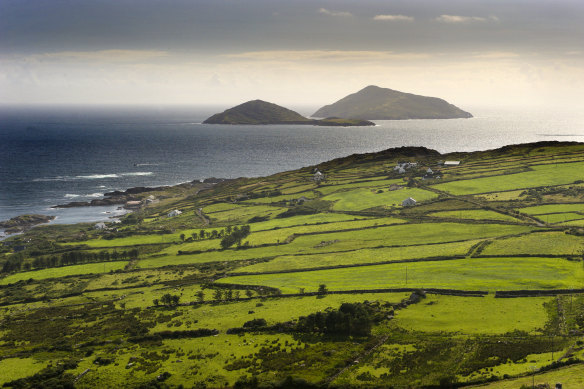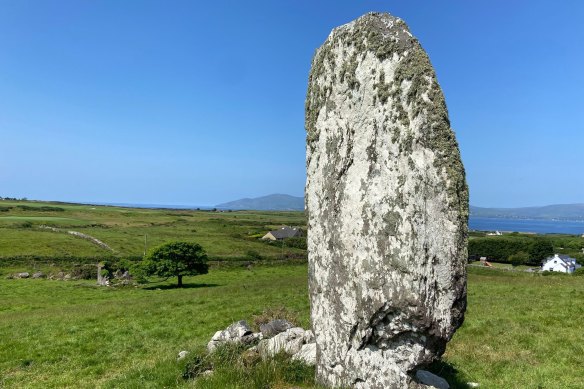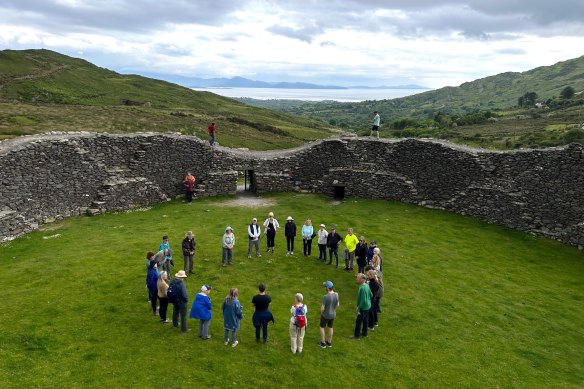This was published 10 months ago
‘You are not tourists here’: In Ireland, there’s still a place for wonder
For those with an openness to whimsy, the stories from the Irish west coast will subvert normal thinking.
By David Leser

Pasturelands fold into the North Atlantic along the Ring of Kerry, on Ireland’s west coast.Credit: Getty Images
I am standing in an emerald valley with trails leading this way and that. There’s a ringfort in the distance, blanketed in mist, and a ruined abbey up on a hill. Word has it, there’s also a farm nearby where the hens have been taught to pray – The Lord’s Prayer, no less – and an ancient well said to cure diabetes.
“True?” you ask. Well, it all depends on how you look at things. Certainly, it doesn’t make much sense but, then again, neither does the answer to the persistent Irish question: “How do I get there?”
“Well, jaysus,” the old farmer is prone to telling you, grinning down his sleeve. “I wouldn’t be starting from here.” And, of course, that gets you thinking you shouldn’t be going to wherever you thought you were going, not from here anyway, and that you might as well accept you’re very lost. Either that, or there’s somewhere much better to go that you haven’t thought of yet.
Oh dear, how to get there? One thing’s for sure, it’s not by using the logic of a rational mind, certainly not on the west coast of Ireland. Over here, voices come out of the sweet waters and ancient limestone hills, and they tell tales barely believable, certainly rarely heard, in the din of modern life. Tales of leprechauns living in the trunks of fairy trees; ageless gods and goddesses dwelling underground – they call them the Tuath(a) Dé Danann; tales from the beginning of time when the Hag of Beara, at once an old crone and a divine young woman, shaped the land by tossing rocks and stones from her apron until she herself became a stone rising from the waters. The eternal goddess of winter singing the world into being.
Look at the land and witness for yourself the burial mounds, megalithic tombs, obelisk memorials, stone circles and flagstones bearing the hallmarks of great battles fought in ancient times, long before St Patrick banished the snakes in the fifth century. (And don’t for a minute believe these stones are dead. They’re alive, they have beating hearts, they remember everything. No such thing as stone-dead.)
‘You are not tourists here, you are pilgrims,’ Nóirín declares, her beautiful Irish lilt creating its own distinct melody.
Yes, listen to the stories that the Irish love to tell, leg-pulling stories that will enthral and mesmerise. Stories for the eve of battle. Stories for the beginning of spring and the warming of a new home. Stories that draw on the dreams of humankind. Stories that you can take however you please, depending on your openness to wonder and your appetite for fable and riddle.
In geographic terms, this is where the mountains greet the ocean and the pasturelands fold into the wave-battered cliffs of the North Atlantic. In mythical terms, this is where the Celtic imagination takes you through a portal into the unknown, somewhere on the threshold between the visible and invisible worlds. Out here in the west, you’ll hear fantastical stories that will subvert your normal thinking, so much so that months after you’ve returned home – perhaps even years – you’ll still be scratching your head and asking, “How did I get there?”

One of the four Eightercua stones, dating to 1200BC, on the Ring of Kerry.
Ireland is like that. You don’t do Ireland, like you do, say, Paris, Venice or Rome. Ireland does you and it does you slowly, filling your heart with stories, poetry and song.
We hear a lot about the rush of talent pouring out of Ireland these days: actors like Cillian Murphy (Oppenheimer), Barry Keoghan (The Banshees of Inisherin), Andrew Scott (Ripley), Paul Mescal (All of Us Strangers); a new wave of singers such as Denise Chaila, Aoifa Nessa Frances, Sorcha Richardson and Sinead O’Brien; glorious writers like Sebastian Barry (Old God’s Time), Paul Lynch (Prophet Song), Paul Murray (The Bee Sting), Claire Keegan (Small Things like These) and Anne Enright (The Wren, The Wren).
What we don’t hear so much about is the journey of the soul that Ireland can take you on, and that Nóirín Ní Riain and her two sons, Owen and Mícheál “Moley” Ó Súilleabháin took me on this past year when I signed up for their “Turas d’Anam”, meaning, literally, Journey of Your Soul.
The trio offer two such journeys each year, one into “Kingdom County” in County Kerry, named for its ancient chieftains and known for its spectacular coastline, mountains and estuaries, the other into the “Golden Vale”, the heart of Irish dairy country covering parts of counties Cork, Limerick and Tipperary, and the Ó Súilleabháins’ soul home.
My travel schedule takes me to County Kerry, to a cottage on the 200-hectare Parknasilla estate, overlooking an inlet of the Kenmare River where Irish playwright George Bernard Shaw once came to write. “It is a place that does not belong to any world that you or I have ever lived in,” Shaw said of this paradise of woodlands, estuaries and birdsong. “It is part of a dream world.”
My bedroom is on the edge of a rhododendron forest, just off the famed Ring of Kerry and the great stretch of untamed beauty known as the Wild Atlantic Way. My hosts – Nóirín, Owen and Moley – are three of the most delightful characters I’ve ever met, as well as being one of the most distinguished musical families in all of Ireland.
You could write a novel just about Nóirín Ní Riain herself. Once dubbed the high priestess of Gregorian chant by actor Anjelica Huston, Nóirín is a singer, interfaith minister and doctor of theology, whose doctoral thesis on the “sound of God” led to the coining of a new addition to the English language: Theosony, derived from theos, the Greek word for god, and sonos, the Latin word for sound.

Nóirín Ní Riain (in foreground, long denim jacket and white shoes) sings a Gregorian chant to visitors at the Staigue Stone Fort, said to date back to the Iron Age.
Nóirín was formerly married to the late composer, multi-instrumentalist and ethnomusicologist Mícheál Ó Súilleabháin. The couple recorded three albums of Gregorian chants with the Benedictine monks of Glenstal Abbey in County Limerick and, together, produced two sons – Owen, a singer, composer, teacher and leadership coach, and Moley, a poet, singer and musician specialising in Irish rap.
“You are not tourists here, you are pilgrims,” Nóirín declares on our first morning, her beautiful Irish lilt creating its own distinct melody. “And there’s a big difference between a pilgrim and a tourist. A tourist is here to be amused and to be entertained and to drink Guinness. Now, you can do that, too. But a pilgrim is here for a purpose.”
And that, of course, raises the question: What is our purpose? What is mine? Is it not enough just to be here, west of Europe, west of Ireland, west of west, gathering in the mornings for songs, stories, poetry and myth; taking evening walks in silence towards the setting sun; learning lessons from the “sally” or willow trees, willows that apparently never wept because the Jewish people were weeping for their freedom under poplars by the rivers of Babylon, not willows.
“It’s a terrible mistranslation from the Old Testament,” Owen tells us one bright morning. “In Celtic culture, the poplar is associated with grief, so we should really call it the weeping poplar and the happy willow.”
Is it not enough to hear stories such as this, and to sip fine malt whiskey at dusk, dipping your lids to George Bernard Shaw in a bar called Doolittle on the Parknasilla Estate? Then to savour a meal of pan-roasted sea bass and garden vegetables next door in the Pygmalion Room, while the evening light fades over Kenmare Bay? Would I not be sated simply listening to Nóirín and her boys singing a cappella beside the miraculous waters of St Michael’s well, feeling the energy lines running from Ballinskelligs to Jerusalem? Or listening to Owen plucking his guitar, singing old Irish songs that his mother helped reintroduce to their country? Or drinking in the words of Moley reciting one of his beautiful poems from his collection, Early Music, this one called The Skylark, where the “skylarks beat their wings” and a farmer roars his welcome with the words: “Do not underestimate the circumstances that brought you here?”
I do not underestimate anything here, but I am still trying to decipher the meaning of it all, while relishing the fact that, in this often deeply cynical world of ours, there’s still a place for wonder, for where fancy can still take flight. “We have always found the Irish a bit odd,” Winston Churchill once said. “They refuse to be English.”
Thank heavens for that.
To read more from Good Weekend magazine, visit our page at The Sydney Morning Herald, The Age and Brisbane Times.